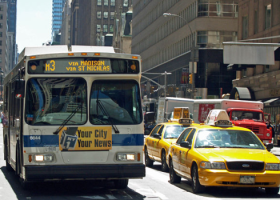NYS Commission Approves Congestion Pricing Plan
 This post is by Sheryl Canter, an Online Writer and Editorial Manager at Environmental Defense.
This post is by Sheryl Canter, an Online Writer and Editorial Manager at Environmental Defense.
 New York City suffers from some of the worst traffic congestion in the country, costing workers and businesses billions of dollars a year in lost time, and heavily contributing to New York’s nearly worst-in-the-nation air quality. One in eight New Yorkers suffer from asthma. And New York is expected to add one million residents by 2030.
New York City suffers from some of the worst traffic congestion in the country, costing workers and businesses billions of dollars a year in lost time, and heavily contributing to New York’s nearly worst-in-the-nation air quality. One in eight New Yorkers suffer from asthma. And New York is expected to add one million residents by 2030.
New York State charged a commission of elected officials, and environmental and planning experts with solving New York City’s traffic crisis. Andy Darrell, Regional Director for Living Cities at Environmental Defense, was one of the commissioners. Today the commission voted to approve an historic plan to protect New Yorkers’ health.
A key element of the plan is congestion pricing, where an electronically-collected fee system charges drivers more for using the most congested roads at the most congested times. This encourages drivers to instead use mass transit or to reschedule their trip. Cities around the world are successfully using congestion pricing to reduce traffic and pollution from vehicle exhausts.
Today’s approved plan included the following elements:
- A congestion pricing system for New York’s Central Business District (CBD) from 60th street to the southern tip of Manhattan, with a charge in effect only during the peak traffic times (6 a.m. to 6 p.m., Monday-Friday). The plan will cut traffic in the CBD and outside of the CBD by reducing through-traffic destined for the CBD from Brooklyn, Queens, the Bronx, and northern Manhattan, areas with the city’s highest asthma rates.
- A guarantee that about $500 million in annual revenue will be invested in transit expansion. This will reduce the $30 billion backlog in capital investment needed for major projects – for example, a Second Avenue subway line, and bus service in neighborhoods that lack transit options now.
- A simple and relatively inexpensive system with far fewer cameras and operational complexity than that used in London, saving about $100 million annually from earlier estimates.
- Recommended solutions to key concerns such as:
- A transit "lockbox" that guarantees revenue to new transit expansion.
- Short-term transit improvements prior to the program’s start.
- Residential parking permits and ongoing monitoring and mitigation efforts to reduce traffic and parking in surrounding neighborhoods.
- A sound legal framework for environmental review.
- Cutting cameras from 340 down to 25 (93% reduction) and putting strict limits on storing personal information to ensure privacy.
- Increased enforcement of existing traffic laws and a crackdown on placards.
- Tax relief for low income drivers with no transit alternative (who are fewer than 1 percent of all commuters to the CBD).
Investing now in the transit system of tomorrow will keep New York City accessible to people of all income levels, cut pollution, support healthy growth, and cut global warming pollution. Congestion pricing is the key to clean air and better transit.












One Comment
Bad news for the congestion pricing plan in New York city…..or is there a silver lining somewhere?
http://cityroom.blogs.nytimes.com/2008/04/07/congestion-pricing-plan-is-dead-assembly-speaker-says/index.html?hp